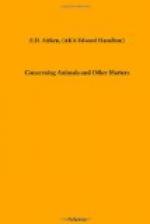[Illustration: A BLACKBIRD AND A STARLING—THE ONE LIFTS ITS SKIRTS, WHILE THE OTHER WEARS A WALKING DRESS.]
In this connection I may also say that the shape or colour of a tail is not everything. An observant eye may find much to note in the wearing of them. There is a stylish way of carrying a tail and a slovenly way, and there are coquettish arts for the display of recherche tails. A blackbird and a starling are both tidy birds, and both walk much on the ground, but the one lifts its skirts, while the other, more practical and less fashionable, wears a walking dress and saves itself trouble.
This line of observation leads to a higher, and reveals the most important purpose that tails have served in the economy of beast, bird, and reptile, and, perhaps, even cold-blooded fish. Before the godlike countenance of man appeared on the earth, with its contractile forehead and erectile eyebrows, the answering light of the eye, the expansive nostrils, and subtilely mobile lips; before that the tail was the prime vehicle of emotion and safety-valve of passion. It is a great truth, too often buried in these days under rubbish of materialistic theories, that some way of self-manifestation is a supreme necessity of all sentient life. From the hot centre of thought and feeling the currents rush along the nervous ways and pervade the whole frame, seeking an outlet. But many passages are barred by duty, or fear, or eager purpose. A strong gust of passion may burst all barriers and force its way out at every point, but gentle currents flow along the lines of least resistance and find the idle tail. I do not know a better illustration of this than a cat watching a mouse. The ears are pricked forward, the eyes are fixed on the unsuspecting victim, every muscle of the legs is tense, like a bent bow ready to speed the arrow on its way. But see, the excitement with which the whole body is charged cannot be wholly restrained, and oozes out at the point of the tail.
[Illustration: AT THE SIGHT OF A RIVAL THE DOG HOLDS ITS TAIL UP STIFFLY]
Every emotion and passion takes this course. The happy kid wags its tail as it runs to its mother, the donkey when it has executed a successful bray, and the dog when it sees its master. At the sight of a rival the dog holds its tail up stiffly, unless, indeed, the rival is a bigger dog than itself, in which case the index goes down quickly between the legs. An elated horse elevates its tail, and so does a duck in the same mood. A lizard preparing to fight another lizard




